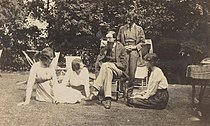Lady Ottoline Morrell

The Lady Ottoline Violet Anne Morrell (June 16, 1873 – April 21, 1938) was an English aristocrat and society hostess. Her patronage was influential in artistic and intellectual circles, where she befriended writers such as Aldous Huxley, Siegfried Sassoon, T. S. Eliot and D. H. Lawrence. She had love affairs with historically significant men and women such as philosopher Bertrand Russell and painter Dora Carrington.
Early life
Born Ottoline Violet Anne Cavendish-Bentinck, she was granted the rank of a daughter of a duke with the courtesy title of "Lady" when her half-brother William succeeded to the Dukedom of Portland in 1879, at which time the family moved into Welbeck Abbey in Nottinghamshire.
Lady Ottoline was a descendant of Bess of Hardwick and as such had many aristocratic connections. Her best-known relative was her cousin Lady Elizabeth Bowes-Lyon, who married the Duke of York (later King George VI) in 1923, became Queen when his brother, King Edward VIII, abdicated in 1936, and spent most of the twentieth century known as the Queen Mother.
Notable love affairs
Throughout her life, Ottoline was an incurable romantic. Her first love affair was with an older man, the doctor and writer Axel Munthe, but she rejected his impulsive proposal of marriage because her spiritual beliefs were incompatible with his atheism — only to find that he had already lost interest in her anyway.
She married the would-be Liberal politician, Philip Morrell, in 1902, with whom she shared many views and interests. They shared what would now be known as an open marriage for the rest of their lives: both she and her husband had affairs and relationships with other people, while supporting and sticking with each other. The Morrells had one child, a daughter, Julian.
Ottoline was involved with, among others, philosopher Bertrand Russell, painter Augustus John, artist Dora Carrington, novelist Dorothy Bussy, and artist Roger Fry. She also became good friends with writer Virginia Woolf. Many of these people shared her bisexuality and outlook on society.
Hospitality
They maintained a townhouse in Bloomsbury, Central London, and a country house at Garsington Manor near Oxford. Ottoline delighted in opening both as havens for like-minded people.[1] The townhouse served as her salon, and the manor as a convenient retreat, near enough to London for many of their friends to join them for weekends.
During World War I, the Morrells were notable pacifists, not a popular position then. They invited conscientious objectors such as Duncan Grant and David Garnett to take refuge at Garsington. Siegfried Sassoon, recuperating there after an injury, was encouraged to go absent without leave in a protest against the war.
The hospitality offered by the Morrells was such that most of their guests had no suspicion that they were in financial difficulties.
Later life
Later, Lady Ottoline remained a regular host to the adherents of the Bloomsbury Group, and many other artists and scholars. She could certainly be considered as a patron to many of them, while not devoid of artistic aspirations (of an extravagant camp-like kind) herself too.
Her after-life in literature
Perhaps Lady Ottoline's most interesting legacy are the representations of her that appear in 20th century literature. She was the inspiration for Mrs Bidlake in Aldous Huxley's Point Counter Point, for Hermione Roddice in D. H. Lawrence's Women in Love, for Lady Caroline Bury in Graham Greene's It's a Battlefield, and for Lady Sybilline Quarrell in Alan Bennett's Forty Years On. The Coming Back (1933), another novel which portrays her, was written by Constance Malleson, one of Ottoline's many rivals for the affection of Bertrand Russell. Some critics consider her as the inspiration for Lawrence's Lady Chatterley [1]. Huxley's roman à clef, Crome Yellow depicts the life at a thinly-veiled Garsington.
Non-literary portraits are also part of this interesting legacy, for example, as seen in the artistic photographs of her by Cecil Beaton and others.
Biography
- Seymour, Miranda, Ottoline Morrell: Life on a Grand Scale, New York: Farrar Straus Giroux, 1993, ISBN 0374228183 and London: Hodder & Stoughton, 1998, ISBN 0340518200.
